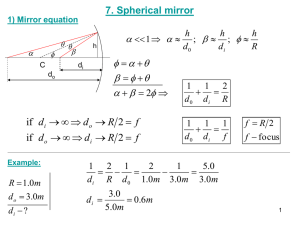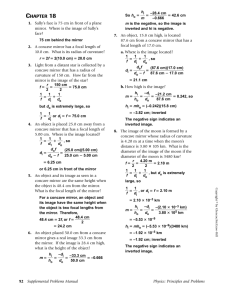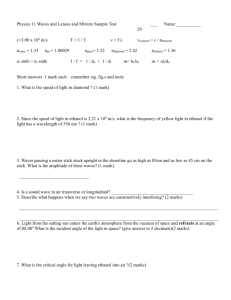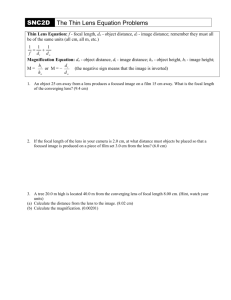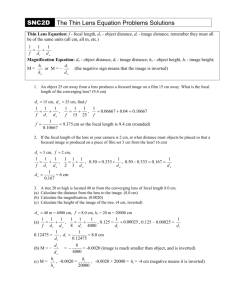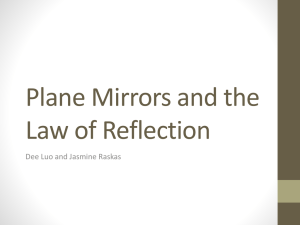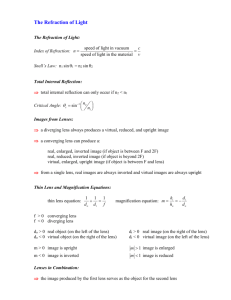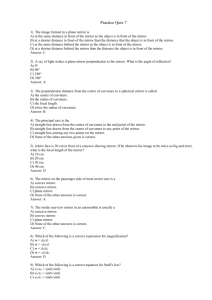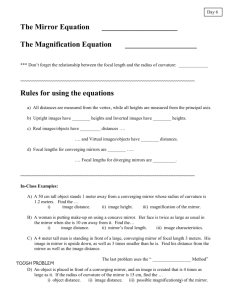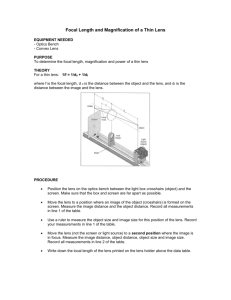Chapter 17 continued - Newark Catholic High School
advertisement
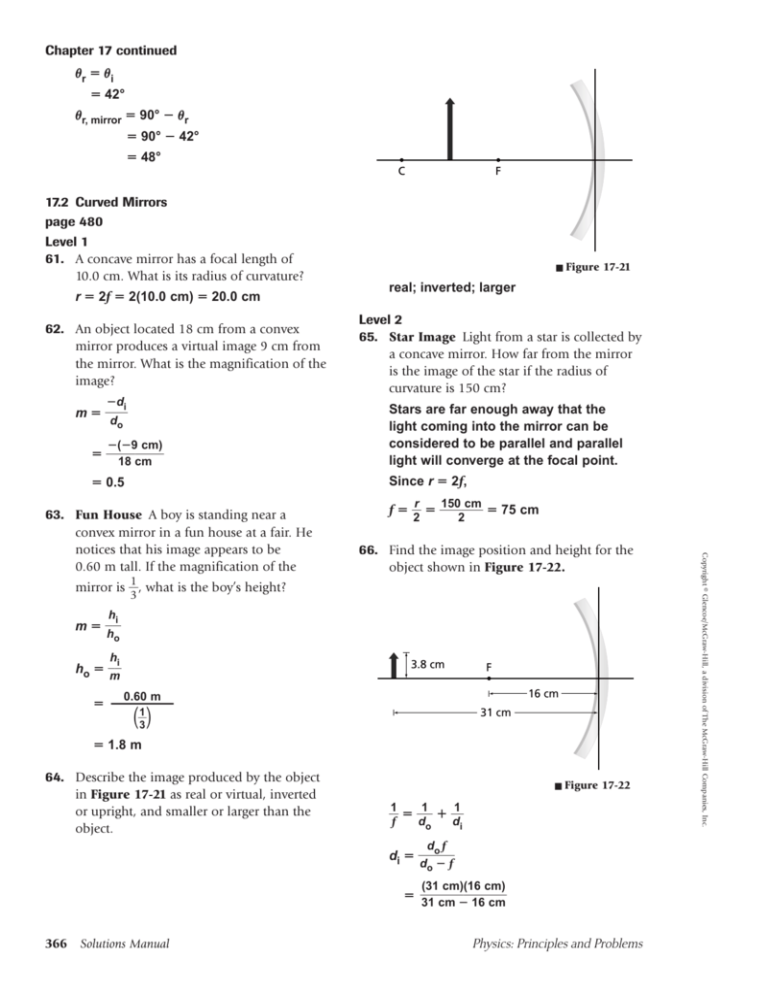
Chapter 17 continued r i 42° r, mirror 90° r 90° 42° 48° 17.2 Curved Mirrors page 480 Level 1 61. A concave mirror has a focal length of 10.0 cm. What is its radius of curvature? r 2f 2(10.0 cm) 20.0 cm 62. An object located 18 cm from a convex mirror produces a virtual image 9 cm from the mirror. What is the magnification of the image? di C F ■ Figure 17-21 real; inverted; larger Level 2 65. Star Image Light from a star is collected by a concave mirror. How far from the mirror is the image of the star if the radius of curvature is 150 cm? Stars are far enough away that the light coming into the mirror can be considered to be parallel and parallel light will converge at the focal point. 0.5 Since r 2f, m do (9 cm) 18 cm r 2 150 cm 2 f 75 cm 66. Find the image position and height for the object shown in Figure 17-22. 1 3 mirror is , what is the boy’s height? hi m ho hi ho 3.8 cm m F 16 cm 0.60 m 13 31 cm 1.8 m 64. Describe the image produced by the object in Figure 17-21 as real or virtual, inverted or upright, and smaller or larger than the object. ■ Figure 17-22 1 1 1 f do di d f do f di o (31 cm)(16 cm) 31 cm 16 cm 366 Solutions Manual Physics: Principles and Problems Copyright © Glencoe/McGraw-Hill, a division of The McGraw-Hill Companies, Inc. 63. Fun House A boy is standing near a convex mirror in a fun house at a fair. He notices that his image appears to be 0.60 m tall. If the magnification of the Chapter 17 continued 33 cm what is the magnification of the image? hi di ho do m diho hi do (33 cm)(3.8 cm) 31 cm 4.1 cm 67. Rearview Mirror How far does the image of a car appear behind a convex mirror, with a focal length of 6.0 m, when the car is 10.0 m from the mirror? 1 1 1 do di f d f do f di o (10.0 m)(6.0 m) 10.0 m (6.0 m) Copyright © Glencoe/McGraw-Hill, a division of The McGraw-Hill Companies, Inc. 3.8 m 68. An object is 30.0 cm from a concave mirror of 15.0 cm focal length. The object is 1.8 cm tall. Use the mirror equation to find the image position. What is the image height? 1 1 1 do di f d f do f di o (30.0 cm)(15.0 cm) 30.0 cm 15.0 cm 30.0 cm hi di m ho do diho hi do (30.0 cm)(1.8 cm) (30.0 cm) 1.8 cm 69. Dental Mirror A dentist uses a small mirror with a radius of 40 mm to locate a cavity in a patient’s tooth. If the mirror is concave and is held 16 mm from the tooth, Physics: Principles and Problems (40 mm) 2 r 2 f 20 mm 1 1 1 do di f d f do f (16 mm)(20 mm) 16 mm 20 mm di o 80 mm di (80 mm) 16 mm m 5 do 70. A 3.0-cm-tall object is 22.4 cm from a concave mirror. If the mirror has a radius of curvature of 34.0 cm, what are the image position and height? r 2 f 34.0 cm 2 17.0 cm 1 1 1 do di f d f do f di o (22.4 cm)(17.0 cm) 22.4 cm 17.0 cm 70.5 cm hi di ho do m diho hi do (70.5 cm)(3.0 cm) 22.4 cm 9.4 cm Level 3 71. Jeweler’s Mirror A jeweler inspects a watch with a diameter of 3.0 cm by placing it 8.0 cm in front of a concave mirror of 12.0-cm focal length. a. Where will the image of the watch appear? 1 1 1 do di f Solutions Manual 367 Chapter 17 continued d f do f (8.0 cm)(12.0 cm) 8.0 cm 12.0 cm di o 24 cm 1 1 1 do di f fdo b. What will be the diameter of the image? hi di ho do di do f (10.0 cm)(150 cm) 150 cm (10.0 cm) 9.4 cm diho (24 cm)(3.0 cm) 8.0 cm hi do di (9.4 cm) 150 cm m 0.063 do hi mho (0.063)(12 cm) 0.75 cm 9.0 cm 72. Sunlight falls on a concave mirror and forms an image that is 3.0 cm from the mirror. An object that is 24 mm tall is placed 12.0 cm from the mirror. a. Sketch the ray diagram to show the location of the image. O1 Ray 1 Ray 2 C F Horizontal scale: 1 block 1.0 cm Vertical scale: 1 block 4 mm I1 b. Use the mirror equation to calculate the image position. fd do f pages 480–481 Level 1 74. A light ray strikes a plane mirror at an angle of 28° to the normal. If the light source is moved so that the angle of incidence increases by 34°, what is the new angle of reflection? i i, initial 34° 28° 34° 62° r i 62° 75. Copy Figure 17-23 on a sheet of paper. Draw rays on the diagram to determine the height and location of the image. (3.0 cm)(12.0 cm) 12.0 cm 3.0 cm o di 4.0 cm c. How tall is the image? di 4.0 cm m 0.33 do 12.0 cm 3.0 cm 8.0 cm F 4.0 cm hi mho (0.33)(24 mm) 8.0 mm 73. Shiny spheres that are placed on pedestals on a lawn are convex mirrors. One such sphere has a diameter of 40.0 cm. A 12-cm-tall robin sits in a tree that is 1.5 m from the sphere. Where is the image of the robin and how tall is the image? ■ Figure 17-23 r 20.0 cm, f 10.0 cm 368 Solutions Manual Physics: Principles and Problems Copyright © Glencoe/McGraw-Hill, a division of The McGraw-Hill Companies, Inc. 1 1 1 do di f Mixed Review Chapter 17 continued b. What is the image height? O1 I1 Horizontal scale: 1 block 1.0 cm Vertical scale: 2 blocks 1.0 cm hi 1.0 cm di 2.7 cm hi m ho F diho hi do (22.9 cm)(2.4 cm) 30.0 cm The image height is 1.0 cm, and its location is 2.7 cm from the mirror. Level 2 76. An object is located 4.4 cm in front of a concave mirror with a 24.0-cm radius. Locate the image using the mirror equation. 78. What is the radius of curvature of a concave mirror that magnifies an object by a factor of 3.2 when the object is placed 20.0 cm from the mirror? hi m r f 2 ho 24.0 cm 2 12.0 cm 1 1 1 do di f d f do f di o (4.4 cm)(12.0 cm) 4.4 cm 12.0 cm Copyright © Glencoe/McGraw-Hill, a division of The McGraw-Hill Companies, Inc. 1.8 cm 6.9 cm 77. A concave mirror has a radius of curvature of 26.0 cm. An object that is 2.4 cm tall is placed 30.0 cm from the mirror. a. Where is the image position? r 2 f 26.0 cm 2 13.0 cm 1 1 1 do di f d f di o do f (30.0 cm)(13.0 cm) 30.0 cm 13.0 cm 22.9 cm di mdo (3.2)(20.0 cm) 64 cm 1 1 1 do di f d d do di i f o (20.0 cm)(64 cm) 20.0 cm (64 cm) 29 cm r 2f (2)(29 cm) 58 cm 79. A convex mirror is needed to produce an image one-half the size of an object and located 36 cm behind the mirror. What focal length should the mirror have? hi di ho do m diho do hi (36 cm)h o ho 2 72 cm 1 1 1 do di f Physics: Principles and Problems Solutions Manual 369 Chapter 17 continued dodi a. What kind of mirror would do this job? f do di An enlarged, upright image results only from a concave mirror, with the object inside the focal length. (72 cm)(36 cm) 72 cm (36 cm) b. What is its radius of curvature? 72 cm di m 80. Surveillance Mirror A convenience store uses a surveillance mirror to monitor the store’s aisles. Each mirror has a radius of curvature of 3.8 m. do di mdo (7.5)(14.0 mm) 105 mm a. What is the image position of a customer who stands 6.5 m in front of the mirror? 1 1 1 do di f A mirror that is used for surveillance is a convex mirror. So the focal length is the negative of half the radius of curvature. dodi di do 16 mm r 2f (2)(16mm) 32 mm r 2 f 3.8 m 2 1.9 m 1 1 1 do di f (14.0 mm)(105 mm) 14.0 mm (105 mm) f 82. The object in Figure 17-24 moves from position 1 to position 2. Copy the diagram onto a sheet of paper. Draw rays showing how the image changes. d f do f di o 1 C 2 F 1.5 m 1.0 m b. What is the image height of a customer who is 1.7 m tall? hi di ho do 1.5 m 2.0 m 2.5 m m ■ diho hi do O1 (1.5 m)(1.7 m) 6.5 m Level 3 81. Inspection Mirror A production-line inspector wants a mirror that produces an image that is upright with a magnification of 7.5 when it is located 14.0 mm from a machine part. 370 Solutions Manual O2 1 Ray 1 Ray 2 Ray 2 0.38 m Ray 1 Figure 17-24 2 C F I1 I2 Horizontal scale: 1 block 10 cm 83. A ball is positioned 22 cm in front of a spherical mirror and forms a virtual image. If the spherical mirror is replaced with a plane mirror, the image appears 12 cm closer to the mirror. What kind of spherical mirror was used? Physics: Principles and Problems Copyright © Glencoe/McGraw-Hill, a division of The McGraw-Hill Companies, Inc. (6.5 m)(1.9 m) 6.5 m (1.9 m) Chapter 17 continued The object position for both mirrors is 22 cm. So, the image position for the plane mirror is 22 cm. Because the spherical mirror forms a virtual image, the image is located behind the mirror. Thus, the image position for the spherical mirror is negative. 34 cm 1 1 1 do di f d d do di i f o (22 cm)(34 cm) 22 cm (34 cm) hi 2.4 m di 14 m C F I1 The image is 2.4 m tall, and it is 14 m from the mirror. 86. A 4.0-cm-tall object is placed 12.0 cm from a convex mirror. If the image of the object is 2.0 cm tall, and the image is located at 6.0 cm, what is the focal length of the mirror? Draw a ray diagram to answer the question. Use the mirror equation and the magnification equation to verify your answer. O1 Ray 1 62 cm I1 Ray 2 The focal length is positive, so the spherical mirror is a concave mirror. hi di ho do d d do di i f o hido di ho (12.0 cm)(6.0 cm) 12.0 cm (6.0 cm) (0.28 m)(3.2 m) 1.6 m 1 1 1 do di f d d do di i f o (3.2 m)(0.56 m) 3.2 m (0.56 m) f 12 cm 1 1 1 do di f m 0.56 m F Horizontal scale: 1 block 1.0 cm Vertical scale: 3 blocks 2.0 cm 84. A 1.6-m-tall girl stands 3.2 m from a convex mirror. What is the focal length of the mirror if her image appears to be 0.28 m tall? Copyright © Glencoe/McGraw-Hill, a division of The McGraw-Hill Companies, Inc. Horizontal scale: 1 block 1.0 m Vertical scale: 2 blocks 1.0 m Ray 2 di di, plane 12 cm 22 cm 12 cm Ray 1 O1 12 cm Thinking Critically pages 481–482 87. Apply Concepts The ball in Figure 17-25 slowly rolls toward the concave mirror on the right. Describe how the size of the ball’s image changes as it rolls along. 0.68 m 85. Magic Trick A magician uses a concave mirror with a focal length of 8.0 m to make a 3.0-m-tall hidden object, located 18.0 m from the mirror, appear as a real image that is seen by his audience. Draw a scale ray diagram to find the height and location of the image. Physics: Principles and Problems C ■ F Figure 17-25 Solutions Manual 371 Chapter 17 continued Beyond C, the image is smaller than the ball. As the ball rolls toward the mirror, the image size increases. The image is the same size as the ball when the ball is at C. The image size continues to increase until there is no image when the ball is at F. Past F, the size of the image decreases until it equals the ball’s size when the ball touches the mirror. mirror, what is the focal length of the concave mirror? di, initial do, initial 6.0 cm di di, initial (8.0 cm) 6.0 cm (8.0 cm) 14.0 cm 1 1 1 do di f 88. Analyze and Conclude The object in Figure 17-26 is located 22 cm from a concave mirror. What is the focal length of the mirror? d d do di i f o (6.0 cm)(14.0 cm) 6.0 cm (14.0 cm) f f 1.0101 cm 22 cm ■ 91. Analyze and Conclude The layout of the two-mirror system shown in Figure 17-11 is that of a Gregorian telescope. For this question, the larger concave mirror has a radius of curvature of 1.0 m, and the smaller mirror is located 0.75 m away. Why is the secondary mirror concave? r 2 f do 2 22 cm 2 11 cm 89. Use Equations Show that as the radius of curvature of a concave mirror increases to infinity, the mirror equation reduces to the relationship between the object position and the image position for a plane mirror. 92. Analyze and Conclude An optical arrangement used in some telescopes is the Cassegrain focus, shown in Figure 17-27. This telescope uses a convex secondary mirror that is positioned between the primary mirror and the focal point of the primary mirror. Convex secondary mirror As f → , 1/f → 0. The mirror equation then becomes 1/do 1/di, or do di. 90. Analyze and Conclude An object is located 6.0 cm from a plane mirror. If the plane mirror is replaced with a concave mirror, the resulting image is 8.0 cm farther behind the mirror. Assuming that the object is located between the focal point and the concave 372 Solutions Manual Concave primary mirror F Telescope tube Eyepiece ■ Figure 17-27 a. A single convex mirror produces only virtual images. Explain how the convex Physics: Principles and Problems Copyright © Glencoe/McGraw-Hill, a division of The McGraw-Hill Companies, Inc. The smaller mirror is concave to produce a real image at the eyepiece that is upright. The light rays are inverted by the first concave mirror and then inverted again by the secondary concave mirror. Figure 17-26 Chapter 18 continued 83. If an object is 10.0 cm from a converging lens that has a focal length of 5.00 cm, how far from the lens will the image be? n ng A c sin1 sin1 1.00 1.52 1 1 1 f do di 41.1° When the light ray in the glass strikes the surface at a 62° angle, total internal reflection occurs. d f do f o di (10.0 cm)(5.00 cm) 10.0 cm 5.00 cm 10.0 cm 62° 28° 62° 28° 45° 45° 18.2 Convex and Concave Lenses page 510 Level 1 81. The focal length of a convex lens is 17 cm. A candle is placed 34 cm in front of the lens. Make a ray diagram to locate the image. Copyright © Glencoe/McGraw-Hill, a division of The McGraw-Hill Companies, Inc. di 34 cm O1 F Horizontal scale: 1 block 2 cm di 34 cm F I1 82. A converging lens has a focal length of 25.5 cm. If it is placed 72.5 cm from an object, at what distance from the lens will the image be? 1 1 1 f do di d f do f o di (72.5 cm)(25.5 cm) 72.5 cm 25.5 cm 39.3 cm The image is 39.3 cm from the lens. Physics: Principles and Problems d do h ho m i i d m do i (24 cm) 0.75 32 cm 1 1 1 f do di Ray 1 Ray 2 Level 2 84. A convex lens is needed to produce an image that is 0.75 times the size of the object and located 24 cm from the lens on the other side. What focal length should be specified? d d do di o i f (32 cm)(24 cm) 32 cm 24 cm 14 cm 85. An object is located 14.0 cm from a convex lens that has a focal length of 6.0 cm. The object is 2.4 cm high. a. Draw a ray diagram to determine the location, size, and orientation of the image. O1 Ray 1 hi 1.8 cm di 10.5 cm Ray 2 F Horizontal scale: 1 block 1.0 cm Vertical scale: 1 block 0.4 cm F I1 Solutions Manual 389 Chapter 18 continued b. Solve the problem mathematically. 1 1 1 f do di fnew 2f d f do f o di 2(6.00 cm) (14.0 cm)(6.0 cm) 14.0 cm 6.0 cm 10.5 cm d do h ho b. If the original lens is replaced with a lens having twice the focal length, what are the image position, size, and orientation? m i i d h do i o hi (10.5 cm)(2.4 cm) 14.0 cm 1.8 cm, so the image is inverted 12.0 cm 1 1 1 f do di d f do fnew o new di, new (15.0 cm)(12.0 cm) 15.0 cm 12.0 cm 60.0 cm d do h ho m i i d 86. A 3.0-cm-tall object is placed 22 cm in front of a converging lens. A real image is formed 11 cm from the lens. What is the size of the image? h d m i i ho do d h do h i, new o hi, new do (60.0 cm)(3.0 cm) 15 cm 12 cm The image is inverted compared to the object. i o hi 22 cm 1.5 cm The image is 1.5 cm tall. Level 3 87. A 3.0-cm-tall object is placed 15.0 cm in front of a converging lens. A real image is formed 10.0 cm from the lens. a. What is the focal length of the lens? a. What are the object position and object height? 1 1 1 f do di df i do d f i (5.0 cm)(15.0 cm) 5.0 cm (15.0 cm) 1 1 1 f do di 7.5 cm d d do di m i i o i f (15.0 cm)(10.0 cm) 15.0 cm 10.0 cm 6.00 cm d do h ho d h di o i ho (7.5 cm)(2.0 cm) 5.0 cm 3.0 cm 390 Solutions Manual Physics: Principles and Problems Copyright © Glencoe/McGraw-Hill, a division of The McGraw-Hill Companies, Inc. (11 cm)(3.0 cm) 88. A diverging lens has a focal length of 15.0 cm. An object placed near it forms a 2.0-cm-high image at a distance of 5.0 cm from the lens. Chapter 18 continued b. The diverging lens is now replaced by a converging lens with the same focal length. What are the image position, height, and orientation? Is it a virtual image or a real image? fnew f (15.0 cm) 1 1 1 f di do d f do f o So di (125 m)(1.0000 m) 15.0 cm 125 m 1.00 m 1 1 1 fnew do di, new d f do fnew o new di, new (7.5 cm)(15 cm) 7.5 cm 15 cm 15 cm h ho b. A 1000.0-mm lens is focused on an object 125 m away. What is the image position? d do m i i 1.01 m 1.01103 mm 90. Eyeglasses To clearly read a book 25 cm away, a farsighted girl needs the image to be 45 cm from her eyes. What focal length is needed for the lenses in her eyeglasses? 1 1 1 f di do d d do di o i So f d h i, new o hi, new do (15 cm)(3.0 cm) (25 cm)(45 cm) 25 cm (45 cm) 56 cm 7.5 cm 6.0 cm Copyright © Glencoe/McGraw-Hill, a division of The McGraw-Hill Companies, Inc. This is a virtual image that is upright compared to the object. 18.3 Applications of Lenses pages 510–511 Level 1 89. Camera Lenses Camera lenses are described in terms of their focal length. A 50.0-mm lens has a focal length of 50.0 mm. a. A camera with a 50.0-mm lens is focused on an object 3.0 m away. What is the image position? 1 1 1 f di do do f So di do f (3.0103 mm)(50.0 mm) 3 3.010 mm 50.0 mm 51 mm Physics: Principles and Problems Level 2 91. Copy Machine The convex lens of a copy machine has a focal length of 25.0 cm. A letter to be copied is placed 40.0 cm from the lens. a. How far from the lens is the copy paper? 1 1 1 f di do d f do f o di (40.0 cm)(25.0 cm) 40.0 cm 25.0 cm 66.7 cm b. How much larger will the copy be? h d i i ho do d h do (66.7 cm)(h ) 40.0 cm i o o hi 1.67ho The copy is enlarged and inverted. Solutions Manual 391 Chapter 18 continued 92. Camera A camera lens with a focal length of 35 mm is used to photograph a distant object. How far from the lens is the real image of the object? Explain. 35 mm; for a distant object, do can be considered at , thus 1/do is zero. According to the thin lens equation, di f. Level 3 93. Microscope A slide of an onion cell is placed 12 mm from the objective lens of a microscope. The focal length of the objective lens is 10.0 mm. a. How far from the lens is the image formed? 1 1 1 f di do do f So di do f (12 mm)(10.0 mm) 12 mm 10.0 mm 6.0101 mm b. What is the magnification of this image? di 6.0101 mm 5.0 mo do 12 mm 1 1 1 f di do d f do f o di mm)(20.0 mm) (10.0 10.0 mm 20.0 mm 20.0 mm, or 20.0 mm beneath the eyepiece d. What is the final magnification of this compound system? d (20.0 mm) i me 2.00 do 10.0 mm mtotal mome (5.0)(2.00) 1.0101 392 Solutions Manual a. What are the image position, height, and orientation as formed by the objective lens? Is this a real or virtual image? 1 1 1 f do di d f do f o di (425 cm)(20.0 cm) 425 cm 20.0 cm 21.0 cm d do h ho m i i d h do i o hi (21.0 cm)(10.0 cm) 425 cm 0.494 cm This is a real image that is inverted compared to the object. b. The objective lens image becomes the object for the eyepiece lens. What are the image position, height, and orientation that a person sees when looking into the telescope? Is this a real or virtual image? do, new 25.0 cm di 25.0 cm 21.0 cm 4.0 cm 1 1 1 fnew do, new di, new d f do, new fnew o, new new di, new (4.0 cm)(4.05 cm) 4.0 cm 4.05 cm 3.2102 cm Physics: Principles and Problems Copyright © Glencoe/McGraw-Hill, a division of The McGraw-Hill Companies, Inc. c. The real image formed is located 10.0 mm beneath the eyepiece lens. If the focal length of the eyepiece is 20.0 mm, where does the final image appear? 94. Telescope The optical system of a toy refracting telescope consists of a converging objective lens with a focal length of 20.0 cm, located 25.0 cm from a converging eyepiece lens with a focal length of 4.05 cm. The telescope is used to view a 10.0-cm-high object, located 425 cm from the objective lens. Chapter 18 continued ho, new hi 0.494 cm d do h ho m i i d h do, new i, new o, new hi, new (3.210 cm)(0.494 cm) 2 4.0 cm 4.0101 cm This is a virtual image that is inverted compared to the object. c. What is the magnification of the telescope? h i, new m ho 4.010 cm 1 10.0 cm 4.0 Mixed Review Copyright © Glencoe/McGraw-Hill, a division of The McGraw-Hill Companies, Inc. pages 511—512 Level 1 95. A block of glass has a critical angle of 45.0°. What is its index of refraction? n n1 2 sin c n 2 , n2 1.00 for air n1 sin c 1.00 n1 sin 45.0° 1.41 96. Find the speed of light in antimony trioxide if it has an index of refraction of 2.35. c n v c v n 3.00108 m/s 2.35 1.28108 m/s 97. A 3.0-cm-tall object is placed 20 cm in front of a converging lens. A real image is formed 10 cm from the lens. What is the focal length of the lens? 1 1 1 do f di d d do di o i f (20 cm)(10 cm) 20 cm 10 cm 7 cm Level 2 98. Derive n sin 1/sin 2 from the general form of Snell’s law of refraction, n1 sin 1 n2 sin 2. State any assumptions and restrictions. The angle of incidence must be in air. If we let substance 1 be air, then n1 1.000. Let n2 n. Therefore, n1 sin 1 n2 sin 2 sin 1 n sin 2 sin 1 n sin 2 99. Astronomy How many more minutes would it take light from the Sun to reach Earth if the space between them were filled with water rather than a vacuum? The Sun is 1.5108 km from Earth. Time through vacuum 8 (1.510 km)(1000 m/1 km) d t 8 c 3.0010 m/s 5.0102 s Speed through water 3.00108 m/s c v n 1.33 2.26108 m/s Time through water 8 (1.510 km)(1000 m/1 km) d t 8 v 2.2610 m/s 660 s t 660 s 500 s 160 s (160 s)(1 min/60 s) 2.7 min Physics: Principles and Problems Solutions Manual 393
